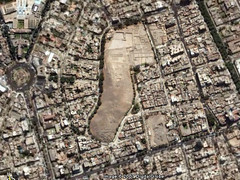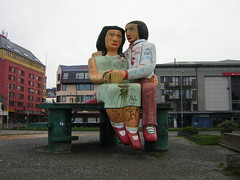Tacna’s double independence celebrations
For Peru’s southern-most region of Tacna, independence celebrations last twice as long as in the rest of the country. For it was this region that gained its freedom twice, the first time from the Spanish, and the second time from Chilean oppression.

Parade with the famous flag
At the end of the War of the Pacific, in which allies Peru and Bolivia were soundly beaten by Chile in a conflict over mineral rights, Chile helped itself to large chunks of Peru and Bolivia’s coasts. The cities of Tacna, Arica and Iquique, once Peruvian, were now at the mercy of the Chile. Further north, outside of the territory Chile wanted to keep, Peruvian towns were burned down and looted, but here, in the mineral rich Atacama, the plan was to coerce the populations into becoming Chilean. In a process called Chileanisation, the subjugated peoples of Peru and Bolivia were banned from celebrating their national days and from raising their flags. Prominent patriots, even priests, were exiled and forced to leave their home lands.
With Chilean troops marching through the streets of Lima, the Chilean flag flying over the Plaza de Armas and delicate negotiations having been made to avoid the Peruvian capital being incinerated and population massacred by soldiers drunk on looted pisco, Peru, in 1883, was forced at gun point to sign over sovereignty of its southern territories and their populations.
Despite tensions caused by Chilean nationalists who tried to drive Peruvian families out of the subjugated regions over almost 50 years, feelings were strong enough to force another international treaty that handed back Tacna, and just Tacna, to Peru. The date was the 28th of August 1925 – Tacna’s second independence day.
In Tacna, yearly celebrations are a month long. Peruvian independence from Spain on the 28th of July is followed by Tacnan freedom from Chile on the 28th of August.
This year, 2009, was like any other, when a huge Peruvian Flag was paraded through the streets.
This dates from 1901 when the people of Tacna invented the tradition of marching with the huge flag in fragrant defiance of all bans on Peruvian symbols, and the flag has now been declared an item of national heritage. To the people of Tacna, it is almost a sacred object.
The procesion began at exactly 2pm, the exact time at which Chile released its stranglehold over the Peruvians who lived in Tacna. The month of celebrations end with the raising of the flag and the lighting of the lamp in the plaza.
Tags: arica, bolivia, chile, independence, iquique, tacna, war of the pacific



![Cusco’s Señor de los Temblores [Featured]](http://farm4.static.flickr.com/3330/3432051172_c4d9ff49f6_m.jpg)






